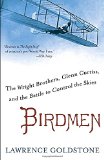Summary | Excerpt | Reviews | Beyond the Book | Readalikes | Genres & Themes | Author Bio
The Wright Brothers, Glenn Curtiss, and the Battle to Control the Skies

Critics' Opinion:
Readers' Opinion:
First Published:
May 2014, 448 pages
Paperback:
Apr 2015, 448 pages
 Book Reviewed by:
Book Reviewed by:
Poornima Apte
Buy This Book
Unfortunately, 1895 was a year before the wondrous achievements that Means sought to publicize had actually occurred. Unable to extol tomorrow, Means devoted his 1895 annual to yesterday. He included extracts from Leonardo, articles by George Cayley, a reprint of his own pamphlet Manflight, wind velocities for 1892, and even some lines from the Iliad. Despite its lack of contemporary content, the Aeronautical Annual was a great success.
Means published two more annuals. The 1896 edition was more up to date, with articles by Chanute; Hiram Maxim, who had invented both the machine gun and a better mouse trap before turning his inventiveness to flight; Samuel Cabot, who wrote on propulsion; J. B. Millet, who reported on an engineer from Australia named Lawrence Hargrave, who had developed a "box kite" from which remarkable results had been achieved; and a brilliant young theorist named Augustus Moore Herring, who contributed an article titled "Dynamic Flight."
The 1897 edition, Means's last, was by far his most influential. He was finally able to bring to the public some significant advances, none more noteworthy than a one-mile flight down the Potomac of a motorized, steam-powered, unmanned "aerodrome" launched by America's most famous scientist and photographed by one of its most famous inventors.
Highway in the Sky
While Lilienthal had demonstrated that properly configured airfoils could provide sufficient lift to support the weight of the apparatus and a person, significant obstacles remained to progress from gliding to controlled, powered flight. In addition to the obvious question of accounting for the weight of any motor that would propel the craft, the issue of how the machine would be controlled once a power source was added had yet to be addressed. Controlled flight would have to involve more than simply traveling from one place to another in an unbroken straight line. Those considering the problem of control used as a paradigm one of two other modern marvels, neither of which ever left the ground. The first, by Karl Benz in 1886, was the incorporation of the internal combustion engine into its most notable application, the automobile. The second was the introduction one year later of what was termed the "safety bicycle."
The marriage of the automobile to Lilienthal's glider principles seemed the more manifestly fruitful. Attaching either a steam or gasoline engine to a set of wings and then "driving" it about the sky seemed a goal within reach. The aim, therefore, would be to build a flying machine that was maximally stable—did not roll side to side or dip—and that would require only limited operator intervention to allow it to handle straight and true. Turns, also like 1890s automobiles, would be wide and slow.
In America, the most prominent advocate of the stable motorized glider was Samuel Pierpont Langley. Like Chanute, Langley was a self-taught civil engineer, but his dozen years in the trade were undistinguished and he eventually turned to astronomy. He first built a telescope, then toured Europe to learn the science. Upon his return, he became an assistant at the Harvard Observatory, moved on to a position at the observatory at the United States Naval Academy, and finally went to Pittsburgh, where he was named professor of physics and director of the Allegheny Observatory, where he remained for two decades.
Lacking skills in mathematics or even the theoretical background in his chosen field, Langley's predilections were to the practical; he was a brilliant administrator and a precise observer, and he had fine instincts for experimentation. For his work in measuring solar radiation, for which he took readings with instruments of his own design, he received international acclaim and was offered the post of assistant secretary of the Smithsonian Institution in 1887. With the current secretary near death, Langley would soon succeed to the post and become the most prominent scientific administrator in the nation.
Excerpted from Birdmen by Lawrence Goldstone. Copyright © 2014 by Lawrence Goldstone. Excerpted by permission of Ballantine Books. All rights reserved. No part of this excerpt may be reproduced or reprinted without permission in writing from the publisher.





The House on Biscayne Bay
by Chanel Cleeton
As death stalks a gothic mansion in Miami, the lives of two women intertwine as the past and present collide.

The Flower Sisters
by Michelle Collins Anderson
From the new Fannie Flagg of the Ozarks, a richly-woven story of family, forgiveness, and reinvention.

The Funeral Cryer by Wenyan Lu
Debut novelist Wenyan Lu brings us this witty yet profound story about one woman's midlife reawakening in contemporary rural China.
Your guide toexceptional books
BookBrowse seeks out and recommends the best in contemporary fiction and nonfiction—books that not only engage and entertain but also deepen our understanding of ourselves and the world around us.